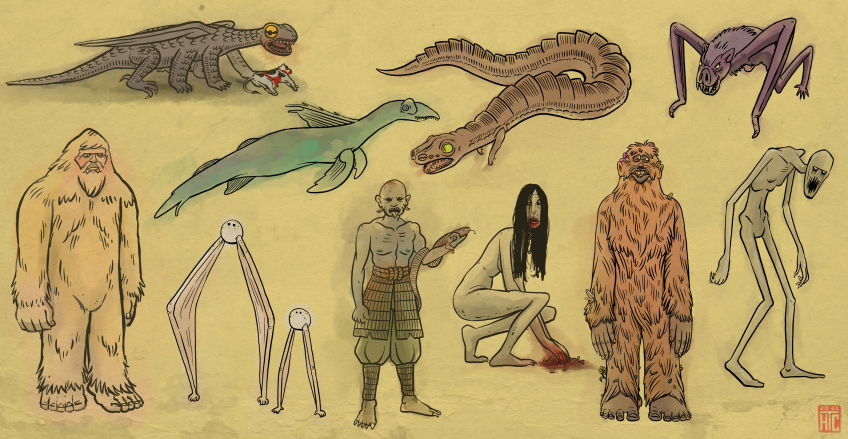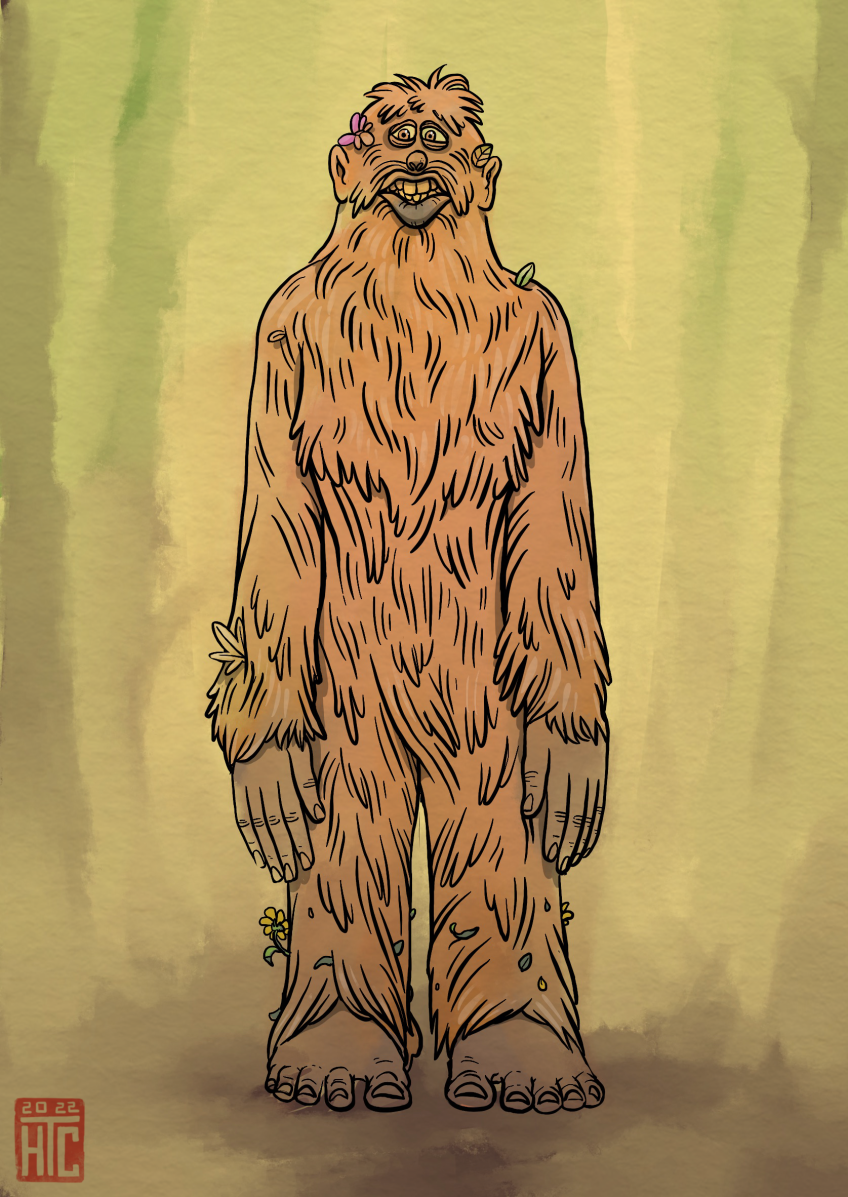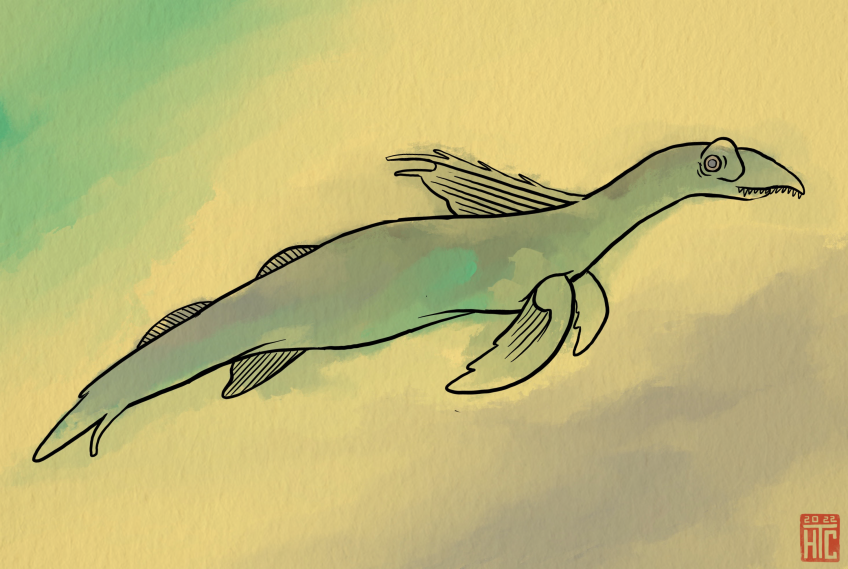Sea Serpents, Reptile Men, Winged Demons and More: Discover 10 Legendary SoCal 'Monsters'

The more that researchers look for as-yet undiscovered species, the more they find.
So, it's not unimaginable that there might be creatures of questionable biology right here in Southern California — perhaps hiding in our bodies of water, lurking in our forests or even exploring our own backyards.
Maybe they're not actual vampires, wolfmen or gill men from the dark waters of a remote lagoon — but every year, the Halloween season tends to give rise to campfire tales of goat-headed devils, lady-faced dogs and other monstrous animals enacting mayhem on unsuspecting victims.
The scientific community calls the study of these monsters "cryptozoology" — or the study of strange animals that can't fully be explained (at least not yet, anyway).
And the stories of these monsters — or "cryptids" — have captivated us for ages, with some legends dating back to the tribal members of our first inhabitants.
So, when things go bump in the night, and the perpetrator appears to be living (and not, you know, undead), here are 10 of our most famous monsters that have scared the pants off generations of Southern Californians.
1. Lizard People, Los Angeles

As their name suggests, the Lizard People were reported to be human — well, sort of human, as the people in this underground civilization, dating back 5,000 years, were supposedly way more advanced than the average Angeleno (even if they didn't actually have any reptilian DNA and just worshipped lizards). In the 1930s, they were first rumored to dwell in a sophisticated tunnel system inside the now-lost Fort Moore Hill (which was leveled for downtown L.A.'s civic center) — where mining engineer G. Warren Shufelt claimed that an X-ray machine he invented had detected the presence of gold tablets. Despite the fact that it was certifiably a hoax, local officials approved the excavation of the hill to look for the buried treasures, of which they found none.
But the Lizard People lore has persisted across nearly a century — even appearing in the 2020 graphic novel, "Lizard In A Zoot Suit" by Marco Finnegan. Over time, the subterranean society's reputation had evolved to become more humanoid than human, too, with an occasional suggestion of alien origins (think of something like the Sleestak living in the Lost City).
Perhaps we can attribute its staying power to its perfect combination of so many things that Angelenos can really get behind: conspiracy theories (like the shapeshifters of the "Reptilian Elite"), tribal legends (apparently derived from Hopi storytelling), ancient civilizations (there's a Mayan connection) and the promise of buried treasure (if not gold, then at least some spooky weird subculture). And because there's a map that's been published, some above-grounders haven't stopped looking for what could be hiding beneath our feet.
2. Idyll-Beast, Idyllwild

If you've ever visited the mountain community of Idyllwild, which is surrounded by the San Jacinto Wilderness and Mt. San Jacinto State Park, you already know that it would be a great place to look for — and probably find — Bigfoot. But Idyllwild doesn't need your garden-variety Sasquatch, because it's got its own monster mascot: the Idyll-Beast.
You can say there's no such thing as the Idyll-Beast, but visit the Idyll-Beast Research Center Museum and Gift Shoppe at 54830 North Circle Drive in Idyllwild-Pine Cove, and you'll see plenty of evidence to the contrary — including a number of postcards for sale and maybe even the beast himself.
In fact, you can even summon him by sending a message to David Jerome, who's been chronicling Idyll-Beast sightings (many by local "beast-ographers," who somehow manage to get clear shots of him) for over a dozen years. He also manages the beast's calendar — including scheduled appearances at the Idyllwild Fourth of July Parade at Idyllwild Town Center.
3. Riverside Monster, Riverside

We've all seen something weird when driving around SoCal late at night — and there's usually a good, reasonable explanation. But in 1958, Charles Wetzel was driving in the city of Riverside, approaching where Main Street crosses over the Santa Ana River (now South Riverside Avenue), when he encountered a mysterious creature he could not only see clearly, but also describe in stunning detail.
Known as the "Riverside Monster" (a.k.a. the Riverside Bridge Monster and the Brain Tickler of Riverside), it was characterized by Wetzel in a UPI dispatch as tall and standing on two legs, with the longest arms he'd ever seen, clawed hands and a body covered in leaf-like scales. Adding to the grotesqueness of the river-bottom resident was a round, scarecrow-like head and glowing eyes, no ears or nose and a protruding mouth that gurgled.
Some say it could've been a hoax — that Wetzel really did see something, but, as The Daily Sun suggested, it was simply a prankster in costume. And nobody has reported a sighting for over 60 years. But if you ever find yourself approaching the Santa Ana River in your car at night — and you find the river overflowing and your radio cutting out, as they did that night — maybe turn around and find another way to your destination.
4. Lake Elsinore Elsie, Lake Elsinore

Scotland's Loch Ness may have "Nessie," but California's Inland Empire has "Elsie," the resident sea monster of Lake Elsinore (a.k.a. the "Loch Elsinore Monster"). Although not California's only lake monster — not by a longshot — Elsie is a city-dwelling, serpentine creature that's made this freshwater lake (SoCal's largest, though technically it's a sag pond) her home at least since 1884, the year of the first reported sighting.
Those are some pretty impressive survival skills, considering the fact that Lake Elsinore has completely dried up a couple of times over the last 130-plus years — including in 1954, when the bone-dry lakebed was completely exposed, no longer offering a watery hiding place for good ol' Elsie. Where did she go? There's plenty of speculation — but the only thing the locals know for sure is that she somehow found her way back. And she's still celebrated, as The Press-Enterprise has reported, as the "unofficial mascot" of Lake Elsinore.
Elsie the Lake Elsinore Monster is here at the library! Share your photos with Elsie using the hashtag #SelfieWithElsie pic.twitter.com/qR8wBL8iMK
— LakeElsinore Library (@LakeElsinoreLib) October 26, 2018
If you're spending time at Lake Elsinore, keep your eyes open for a figure emerging from the surface of the lake with a long neck, a 100-foot-long body and a swishing, 30-foot-long tail. Some describe her as resembling the extinct Triassic-era reptile known as the plesiosaur — which is exactly what the Loch Ness Monster is said to look like.
5. Borrego Sandman, East San Diego County

The San Diego version of Bigfoot — or a larger-than-life, half-human/half-beast with a human face — is known as the Ranchita Yeti (a.k.a. "Rancheti"), the Borrego Sandman, the Wild Man of Warner Springs and the Proctor Valley Monster. Are they all the same creature? Or does this area just attract 400-pound megafauna that walk upright?
Most of the accounts from locals describe this Desert Sasquatch as a light-colored desert dweller, whose pale-colored fur helps him blend in with the stark landscape and nearby sand dunes. Sometimes called the "Abominable Sandman of Borrego," he commands a domain that extends from Anza-Borrego Desert State Park to the East County communities of Warner Springs, Alpine and Ranchita (where you can visit the Rancheti statue at the site of the Montezuma Valley Market, which burned down in 2021 and will be rebuilt as the Ranchita Bodega).
The Sandman was first spotted, however, in 1876 near a spot off the present-day Highway 79 called Deadman's Hole — which was a literal watering hole where a Butterfield stagecoach driver found, you guessed it, a dead man in 1858. Strange occurrences continued to happen there until the furry beast, as big as a bear, revealed himself to two hunters from Julian in a story reported by the San Diego Union newspaper on April Fool's Day, 1888. But if you find any footprints in the sand that measure 24 inches in length, you might want to watch out for a well-camouflaged figure that could be just up the trail.
6. The Devil's Pet, Elizabeth Lake

Elizabeth Lake — west of Lancaster, between the Antelope Valley and Leona Valley — is another lake that's actually a sag pond. That means it was formed by seismic activity along the San Andreas Fault, which helped open up the earth and release underground water into the newly formed basin. Sounds like a situation ripe for strange creatures to come crawling out of their subterranean hiding spaces!
In fact, legend has it that this lake's formation was the handiwork of the devil himself — hence its Spanish nickname, "Laguna del Diablo" — and that the monster that dwells there was one of Satan's own pets. But by the descriptions of it — as large as a whale, with bat-like wings and legs like flippers — it could very well be the Prince of Darkness himself.
Although it hasn't been seen since 1989, the Elizabeth Lake monster's reputation persists — as does the paralyzing fear that the demon (or "water dragon," as the Daily Alta California called it in 1886) will try to steal your soul if you were to encounter it. And if he fails, he just might burn down your entire property.
7. Lone Pine Mountain Devil, Lone Pine

In the Eastern Sierra, there's a folkloric monster that's akin to the East Coast's Jersey Devil: the Lone Pine Mountain Devil. Although it's been described in similar demonic terms to the Elizabeth Lake monster (see #6, above), this winged demon appears to prefer dry land — specifically, the mountains of the Sierra Nevada near the town of Lone Pine.
And unlike the Elizabeth Lake monster, this cryptid is less fish and more feathered and furry — a flesh-eater that appears to kill for the fun of it and not for the feed. No significant or credible sightings are on record since 1928 — which is a good thing, since it's likely to make a snack out of anybody who gets too close and trespasses on his territory. That's what happened, the story goes, when a convoy of Spanish settlers got a little too close — and were swarmed by "beasts damned by the good lord," as reported by padre Justus Martinez, the sole survivor of the massacre.
That's all the Lone Pine Mountain Devil may be — just a story. A post on the USC Digital Folklore Archives site suggests the creature was created for the internet (a phenomenon known as a "creepypasta"), as does author Brian Clune in his book "Legends & Lore Along California's Highway 395." But many still choose to believe in the existence of the monster, even if its official origin story may be a myth.
8. Penelope, Sierra Nevada

If you're enjoying the wilderness near such Eastern Sierra destinations as Tioga Lake, Convict Lake or Mono Lake, look for a tall, nude figure with a witch's face and long, scraggly, light-colored hair.
This mountain monster is named Penelope, a human-like but not quite fully human creature of the female persuasion whose long arms and legs help her hunt through the wilderness and snatch whatever flesh she can get her claws into while raiding campsites in the dead of night. Purported eyewitness accounts describe Penelope as a "pale crawler" with cannibal-like tendencies.
She, too, might be an internet invention, as she shares many qualities with the creepypasta known as a "rake." But if you're in the woods and are disturbed by something you're sure isn't a bear, you may want to keep your distance rather than getting close enough to find out for sure.
9. Fresno Nightcrawler, Fresno

Possibly an alien, the stick figure-like nightcrawler usually associated with the Central Valley once reportedly made an appearance in Yosemite National Park — but it's the caught-on-film encounter in Fresno that made this creature, or creatures, the stuff of legends.
A 2010 episode of the Syfy TV series "Fact or Faked: Paranormal Files" portrayed two of these nightcrawlers that had been captured on a closed-circuit television feed in 2007 — but the original security footage was lost, leaving only a grainy video recorded off a monitor as evidence. The official verdict by the TV experts? "Unexplained." And because of the national-level of celebrity that the Fresno Nightcrawler received, a number of copycats (read: verified hoaxes) popped up in response.
As for the elusive monster itself, which some say looks like a ghostly pair of white pants (hence its nickname, "ghost pants"), it's become somewhat of a pop culture phenomenon — giving rise to T-shirts, pins, stickers and other merchandise. Maybe that's because the Fresno Nightcrawler doesn't seem to do much other than take a gentle little stroll at night.
10. Tahoe Tessie, Lake Tahoe

Lake Tahoe, which straddles the state line between California and Nevada, is North America's largest alpine lake. And it's also the home to Tessie — perhaps a distant cousin of Nessie, a.k.a. the Loch Ness Monster. This lake monster — or "unidentified swimming object" — seems to prefer the Nevada side of the lake, making her home in a tunnel under Cave Rock on its eastern shore.
Tessie has also been somewhat adopted as a symbol of the 3.5 million-year-old lake itself — and of the surrounding communities and their businesses. But her legend began perhaps, as reported by the Los Angeles Times, with the local Washoe Tribe, to whom Cave Rock is sacred. But sightings of the "humped beast" really ramped up in the 1980s, among children and adults alike.
Tessie attending the Bicycle Advisory Committee this morning @ City Hall. #cityofslt #tahoetessie #southlake pic.twitter.com/ByYJ5sRXjY
— City of South Lake Tahoe (@cityofslt) July 11, 2014
Nowadays, if you're looking for Tessie, you can find her in a children's book, on the shelves of the local toy store and even in her own advice column in the Tahoe Daily Tribune. But what's in the lake, then? Experts think it might be a big, prehistoric fish — known as a sturgeon. As many times as divers have explored the depths under Cave Rock, though, they've never found a trace of any egg or droppings that might belong to such a "monster" as Tessie.
All above illustrations by Henry Cram.







